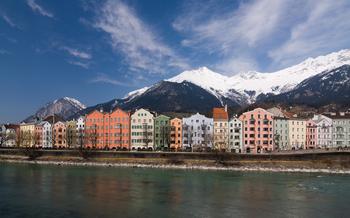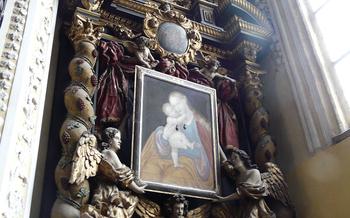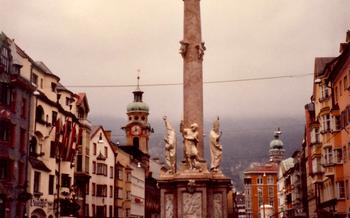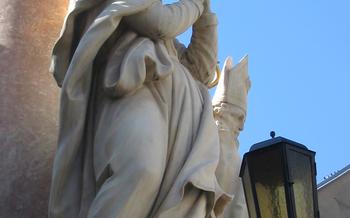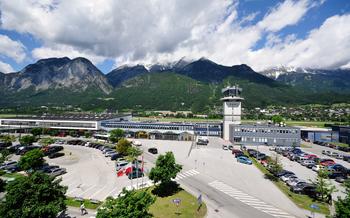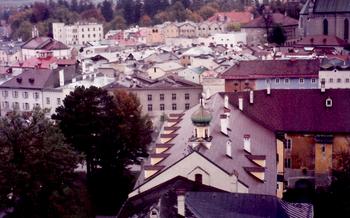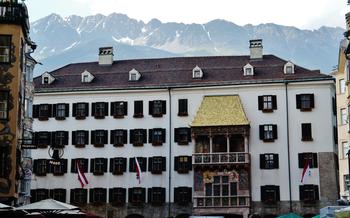
Kaiserliche Hofgarten
- The Imperial Court Garden: An Oasis in the Heart of Innsbruck
- A Stroll through Time: Exploring the Garden's History
- A Masterpiece of Renaissance Landscape Architecture
- A Haven for Plant Lovers: The Garden's Flora
- The Garden's Central Feature: The Renaissance Fountain
- A Place of Reflection and Relaxation: The Garden's Grotto
- The Garden's Contribution to Science and Education
- A Place of Tranquility and Beauty: The Garden's Atmosphere
- The Garden's Surroundings: Exploring Innsbruck's Old Town
- Capture the Moment: Photography in the Garden
- Beyond the Garden: Exploring Innsbruck's Natural Wonders
- Insider Tip: Discovering the Garden's Hidden Gems
The Imperial Court Garden: An Oasis in the Heart of Innsbruck
Innsbruck's Imperial Court Garden, a stunning example of Renaissance landscape architecture, offers a tranquil retreat in the heart of the city. Its origins date back to the 16th century, when Archduke Ferdinand II transformed the former medieval fortifications into a pleasure garden for the Habsburg court. Located just a short walk from the city's historic center, the garden is easily accessible and provides a welcome respite from the hustle and bustle of urban life. Its symmetrical layout, intricate network of paths, and harmonious blend of natural and man-made elements create a serene and inviting space that invites visitors to stroll, relax, and soak in the beauty of their surroundings.
A Stroll through Time: Exploring the Garden's History
The Imperial Court Garden has a rich and storied history that dates back to the 16th century. It was originally conceived as a private garden for Emperor Maximilian I, who was known for his love of nature and horticulture. The garden was later expanded and transformed under the rule of Archduke Ferdinand II, who commissioned the construction of the Renaissance Fountain and other elaborate features. During the 18th century, the garden became a popular gathering place for the aristocracy and wealthy citizens of Innsbruck, who would come to stroll its paths, admire its flowers, and enjoy the fresh air. The garden has continued to evolve over the centuries, but it has retained its original charm and elegance, making it a beloved destination for visitors from all over the world.
The garden's significance as a cultural and social gathering place cannot be overstated. It has been the setting for numerous important events throughout history, including concerts, exhibitions, and even royal weddings. The garden has also played a role in promoting tourism and cultural exchange, as it has attracted visitors from all over Europe and beyond. Today, the Imperial Court Garden remains a vibrant and dynamic space that continues to captivate and inspire visitors with its beauty, history, and cultural significance.
A Masterpiece of Renaissance Landscape Architecture
The Imperial Court Garden is a prime example of Renaissance landscape architecture, showcasing a harmonious blend of symmetry, geometry, and natural elements. Its symmetrical layout is immediately apparent, with the garden divided into four quadrants by two main paths that intersect at the central Renaissance Fountain. Each quadrant is further divided into smaller compartments by a network of intricate paths and walkways, creating a sense of order and balance.
The garden's designers skillfully used terraces, fountains, and sculptures to create a visually appealing landscape. The terraces provide different perspectives of the garden, while the fountains add movement and a sense of tranquility. Sculptures, including statues, busts, and reliefs, are strategically placed throughout the garden, adding to its artistic charm and providing focal points for visitors to admire.
The combination of these elements creates a cohesive and harmonious landscape that is both aesthetically pleasing and functional. The Imperial Court Garden is a testament to the skill and creativity of the Renaissance landscape architects who designed it, and it continues to inspire and captivate visitors to this day.
A Haven for Plant Lovers: The Garden's Flora
The Imperial Court Garden is a botanical wonderland, home to a diverse collection of plants and flowers from around the world. Visitors can stroll through themed gardens, such as the rose garden and the alpine garden, admiring the vibrant colors and delicate fragrances of the flora. The garden also plays a crucial role in the cultivation and preservation of rare and endangered species, contributing to the conservation of our planet's biodiversity.
Among the highlights of the garden's collection are the meticulously maintained rose beds, featuring over 1,000 varieties of roses in an array of colors and scents. The alpine garden showcases a diverse range of plants adapted to the harsh conditions of high mountain environments, providing visitors with a glimpse into the unique flora of the Alps.
The Imperial Court Garden is not just a place of beauty but also a center for botanical research and education. The University of Innsbruck's Botanical Garden is located within the Imperial Court Garden, providing a living laboratory for students and researchers to study the diversity and ecology of plants.
Whether you are a seasoned botanist or simply a nature enthusiast, the Imperial Court Garden offers a rich and rewarding experience, inviting you to explore the wonders of the plant kingdom in a breathtaking setting.
The Garden's Central Feature: The Renaissance Fountain
At the heart of the Imperial Court Garden, a magnificent Renaissance fountain stands as a testament to the garden's grandeur and opulence. Constructed in the 16th century, the fountain is a masterpiece of craftsmanship and artistry, embodying the spirit of the Renaissance period. Its intricate design, adorned with allegorical figures, mythical creatures, and elaborate water features, reflects the prevailing taste for classical motifs and symbolism.
The fountain's central figure, Neptune, the Roman god of the sea, commands attention with his imposing presence. Surrounded by a retinue of water nymphs, tritons, and dolphins, Neptune presides over the fountain's cascading waters, creating a mesmerizing spectacle. The fountain's symbolism extends beyond its aesthetic appeal, representing the power and dominion of the Habsburg dynasty, who commissioned the garden's creation.
Positioned as the focal point of the garden's symmetrical layout, the Renaissance fountain serves as a visual anchor, drawing the eye towards its intricate details and allegorical narratives. Its harmonious proportions and integration with the surrounding landscape create a sense of balance and unity, showcasing the garden's masterful design and the Renaissance fascination with order and symmetry.
A Place of Reflection and Relaxation: The Garden's Grotto
In the heart of the Imperial Court Garden lies a hidden gem that invites visitors to a realm of tranquility and introspection: the Renaissance grotto. Constructed in the 16th century, this subterranean chamber is a testament to the Renaissance fascination with the natural world and the power of imagination. Its walls are adorned with intricate carvings that depict mythical creatures, scenes from classical mythology, and the abundant flora and fauna of the Alps.
The grotto was designed as a place for meditation and contemplation, a refuge from the bustling court life above. Its cool, damp atmosphere and the gentle sound of dripping water create a unique and immersive experience that transports visitors to another time and place. The grotto's acoustics are particularly remarkable, enhancing the sense of serenity and seclusion. It is said that Archduke Ferdinand II, a passionate patron of the arts and sciences, would often retreat to the grotto to seek inspiration and solace.
Today, the grotto remains a popular spot for visitors to the Imperial Court Garden who seek a moment of tranquility amidst the beauty of nature. It is a place to pause, reflect, and appreciate the harmony between the natural and the man-made.
The Garden's Contribution to Science and Education
The Imperial Court Garden has played a significant role in the advancement of botanical research and education. In the 19th century, the garden became a center for botanical studies and was instrumental in the establishment of the University of Innsbruck's Botanical Garden. The university's botanical collection was initially housed within the Imperial Court Garden, providing students and researchers with a living laboratory for the study of plants and their cultivation.
The garden's diverse collection of plants and flowers, as well as its thematic gardens, such as the rose garden and the alpine garden, have been invaluable resources for botanical research. The garden has been used for studies on plant taxonomy, genetics, and ecology, contributing to our understanding of the natural world and its biodiversity.
The Imperial Court Garden continues to be an important educational and research facility. The University of Innsbruck's Botanical Garden, which is now located within the garden, offers guided tours and educational programs for students and the public. The garden also hosts workshops, seminars, and exhibitions on various botanical topics, promoting knowledge and awareness of the plant world.
A Place of Tranquility and Beauty: The Garden's Atmosphere
Stepping into the Imperial Court Garden is like stepping into a peaceful oasis in the heart of Innsbruck. The serene atmosphere envelops visitors, offering a respite from the hustle and bustle of city life. The combination of natural and man-made elements creates a harmonious and inviting space that transports visitors to a different time and place.
The garden's symmetrical layout, with its intricate network of paths and walkways, invites visitors to stroll leisurely and admire the beauty of their surroundings. The gentle sound of water flowing from the Renaissance Fountain adds to the tranquil ambiance, creating a soothing and calming effect.
The garden's lush greenery, with its diverse collection of plants and flowers, provides a feast for the eyes. The vibrant colors and delicate fragrances create a sensory experience that is both captivating and calming. The garden's thematic gardens, such as the rose garden and the alpine garden, offer visitors a chance to explore different plant species and learn about their unique characteristics.
The garden's sculptures and fountains add an artistic dimension to the tranquil atmosphere. The works of renowned artists, such as Giovanni Battista Albanese and Christoph Brock, adorn the garden, creating a visual feast that complements the natural beauty of the surroundings.
The garden's grotto, with its unique atmosphere and acoustics, offers a place for reflection and contemplation. The interplay of light and shadow within the grotto creates a sense of mystery and serenity, inviting visitors to pause and appreciate the beauty of nature.
Overall, the Imperial Court Garden is a place where visitors can escape the stresses of everyday life and immerse themselves in a world of tranquility and beauty. It is a place to slow down, appreciate the finer things in life, and reconnect with nature.
The Garden's Surroundings: Exploring Innsbruck's Old Town
The Imperial Court Garden is nestled in the heart of Innsbruck's historic center, making it an ideal starting point for exploring the city's many other attractions. Just a short walk away lies the Hofburg Imperial Palace, a magnificent complex that once served as the residence of the Habsburg rulers. Today, the palace houses several museums, including the Tyrolean State Museum, which offers a fascinating glimpse into the region's history and culture.
Another must-see attraction is the Golden Roof, a stunning late Gothic balcony adorned with 2,657 fire-gilded copper tiles. This iconic landmark is located just a few steps from the Imperial Court Garden, providing a perfect opportunity to combine nature and history in one unforgettable visit. Innsbruck's Old Town is a treasure trove of architectural wonders, with narrow cobblestone streets, charming courtyards, and historic buildings that tell the story of the city's rich past. Whether you're interested in art, history, or simply soaking up the vibrant atmosphere, Innsbruck's Old Town has something to offer everyone.
Capture the Moment: Photography in the Garden
The Kaiserliche Hofgarten is a photographer's paradise, offering endless opportunities to capture its beauty and charm through the lens. With its vibrant colors, intricate details, and stunning compositions, the garden is a feast for the eyes.
For the best photography experience, plan your visit during the golden hours, just after sunrise or before sunset, when the light is soft and warm, casting a magical glow on the garden. This is the ideal time to capture the intricate details of the Renaissance Fountain, the delicate petals of the roses, and the lush greenery of the alpine garden.
Take advantage of the garden's many landmarks and features to create stunning compositions. The symmetrical layout and intricate network of paths provide leading lines that draw the viewer's eye into the image. Experiment with different angles and perspectives to capture unique and captivating shots.
Don't miss the opportunity to capture the garden's hidden gems, such as the secluded grotto or the tranquil reflection pool. These spots offer unique perspectives and a chance to capture the garden's serene atmosphere.
Remember to respect the garden's rules and regulations regarding photography, especially when it comes to using tripods or professional equipment. With a little planning and creativity, you can capture the essence of the Kaiserliche Hofgarten and create lasting memories of your visit.
Beyond the Garden: Exploring Innsbruck's Natural Wonders
Innsbruck is not just home to the Imperial Court Garden; it is also a gateway to the breathtaking Tyrolean Alps. The city is surrounded by majestic mountains, lush forests, and sparkling lakes, inviting visitors to explore the region's natural wonders.
For those who love hiking, Innsbruck offers a vast network of trails that wind through the picturesque Alpine landscapes. Whether you prefer leisurely walks or challenging treks, there's a trail for every level of fitness.
The Nordkette mountain range, located just a short distance from the city center, is a popular destination for hikers and nature enthusiasts. The Hungerburgbahn funicular takes visitors up to the top of the mountain, where they can enjoy stunning views of Innsbruck and the surrounding peaks. From there, hikers can embark on a variety of trails, including the challenging Hafelekarspitze summit hike.
Innsbruck is also a great place to experience winter sports. The city is home to several ski resorts that offer slopes for all levels of skiers and snowboarders. The Nordkette Ski Area, located just minutes from the city center, offers a variety of runs, from gentle slopes for beginners to challenging off-piste terrain for experts.
Whether you're looking for a relaxing hike in the mountains or an adrenaline-pumping skiing adventure, Innsbruck has something to offer everyone. The city's natural surroundings provide a perfect complement to the cultural and historical attractions of the Imperial Court Garden, making it an ideal destination for travelers who want to experience the best of both worlds.
Insider Tip: Discovering the Garden's Hidden Gems
Beyond the main attractions of the Imperial Court Garden, there are hidden gems waiting to be discovered by those who venture off the beaten path. One such secret spot is the small, secluded garden located behind the Renaissance Fountain. Surrounded by lush greenery and fragrant flowers, this hidden oasis offers a tranquil escape from the crowds and a chance to immerse oneself in the garden's serene atmosphere.
Another hidden gem is the Alpine Garden, which showcases a diverse collection of plants and flowers native to the Tyrolean Alps. Nestled on a hillside within the Imperial Court Garden, the Alpine Garden offers stunning views of the surrounding mountains and a unique opportunity to learn about the region's rich flora.
For those seeking a truly unforgettable experience, the best time to visit the Imperial Court Garden is during the early morning hours, when the air is still cool and the garden is bathed in a soft golden light. As the sun rises, the garden comes alive with the sounds of birdsong and the gentle rustling of leaves, creating a magical and enchanting atmosphere.
With its hidden corners, secret gardens, and unique experiences, the Imperial Court Garden offers something for everyone. Whether you are a history buff, a nature lover, or simply seeking a tranquil oasis in the heart of Innsbruck, this remarkable garden is sure to captivate and enchant you.
